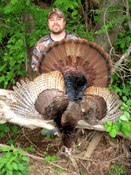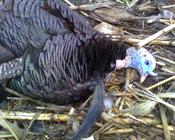 In typical fashion, I’m writing this one about 3 weeks too late. In some respects, it’s nice putting the words together right now, especially after being inspired by Brad’s 2010 recap post. While the details of the exact events need to be researched via my journal, the bigger picture comes into better focus overall. While not original in concept, the stories are a bit different anyway, though not-surprisingly, the lessons I take away from this year’s hunts are very similar to Brad’s.
In typical fashion, I’m writing this one about 3 weeks too late. In some respects, it’s nice putting the words together right now, especially after being inspired by Brad’s 2010 recap post. While the details of the exact events need to be researched via my journal, the bigger picture comes into better focus overall. While not original in concept, the stories are a bit different anyway, though not-surprisingly, the lessons I take away from this year’s hunts are very similar to Brad’s.
 The WI "E" season came just after a period of heavy rains and cooler weather. No doubt we were in the right place at the right time, at least in terms of what mother nature had in store for us. But as of 7AM the opening day, Rick (Flip) and I had yet to hear a gobble. What we did hear was a half gobble/cough/croak that was surely a jake exercising his vocals. That jake with 6 other buddies came to within 7 feet with a loud-mouth hen that apparently wasn’t covering ground to make best-friends. They hung around forever, but eventually cleared, giving us some time to put a sneak on two gobblers in an open field. We had a good cut-off plan, but the gobbler slipped past just out of range. Oh well, time to get some much deserved shut-eye. Naps are all part of the process, especially when you’ve hunted nearly two weeks straight.
The WI "E" season came just after a period of heavy rains and cooler weather. No doubt we were in the right place at the right time, at least in terms of what mother nature had in store for us. But as of 7AM the opening day, Rick (Flip) and I had yet to hear a gobble. What we did hear was a half gobble/cough/croak that was surely a jake exercising his vocals. That jake with 6 other buddies came to within 7 feet with a loud-mouth hen that apparently wasn’t covering ground to make best-friends. They hung around forever, but eventually cleared, giving us some time to put a sneak on two gobblers in an open field. We had a good cut-off plan, but the gobbler slipped past just out of range. Oh well, time to get some much deserved shut-eye. Naps are all part of the process, especially when you’ve hunted nearly two weeks straight.
 A quick bite with Brad, Flip, Craig D., and Little G was just the get-up-and-go I needed to head out to where I figured afternoon birds would be eventually feeding towards to roost. I knew that the whole area was "live" so even though I had a blind and dekes with me, I crept up and over every blind spot I had, eventually spotting just the very tips of a tail-fan that was in full-strut. I eased slowly down then belly crawled away from the bird and to the fenceline, a mere 100 yards from his location in a small dip in the field. Just as I snuck a bit closer, I busted a hen sitting on a nest, who got up in the air and flew down the hill. Did I mess it up for good? A quick check on the bird, and he was still strutting. The next one hour was uncomfortable, nerve-wracking, downright shaky, and heart-stopping, all at the same time. I had to get this bird, 40 yards up a fenceline for a 40 yard shot, and after each calling sequence, he’d strut so hard I thought he’d explode. Did I mention he made the hens he was with look like crows? We rode the emotional rollercoaster of a dramatic hen together that gobbler and I, yelps, then cutts, then getting all soft and seductive, then loud again. Nothing would jar him loose. Until I brought out the box call, and mimicked two hens having a yelp-off. He took 10 minutes to strut his way to 43 steps, and with each step closer my heart rate jumped 20 beats per minute until when I eased into the trigger I couldn’t think, breathe, feel….
A quick bite with Brad, Flip, Craig D., and Little G was just the get-up-and-go I needed to head out to where I figured afternoon birds would be eventually feeding towards to roost. I knew that the whole area was "live" so even though I had a blind and dekes with me, I crept up and over every blind spot I had, eventually spotting just the very tips of a tail-fan that was in full-strut. I eased slowly down then belly crawled away from the bird and to the fenceline, a mere 100 yards from his location in a small dip in the field. Just as I snuck a bit closer, I busted a hen sitting on a nest, who got up in the air and flew down the hill. Did I mess it up for good? A quick check on the bird, and he was still strutting. The next one hour was uncomfortable, nerve-wracking, downright shaky, and heart-stopping, all at the same time. I had to get this bird, 40 yards up a fenceline for a 40 yard shot, and after each calling sequence, he’d strut so hard I thought he’d explode. Did I mention he made the hens he was with look like crows? We rode the emotional rollercoaster of a dramatic hen together that gobbler and I, yelps, then cutts, then getting all soft and seductive, then loud again. Nothing would jar him loose. Until I brought out the box call, and mimicked two hens having a yelp-off. He took 10 minutes to strut his way to 43 steps, and with each step closer my heart rate jumped 20 beats per minute until when I eased into the trigger I couldn’t think, breathe, feel….
 The shot was true, and upon walking up to this bird, I knew he’d be one to be proud of. 24.5lbs, 1" spurs, and a noticeable rope for a 10" beard.
The shot was true, and upon walking up to this bird, I knew he’d be one to be proud of. 24.5lbs, 1" spurs, and a noticeable rope for a 10" beard.
Like any season, there were many things done right, and quite a few done wrong as well. I always take the chance to learn how others hunt whenever I can. That, along with self-reflection, and just spending time out there, is what makes you better. Here are a few things I learned this turkey season. They may or may not work for you, as they maybe only applied to the moment, the property of interest, or specific bird’s whims and personalities.
1. Call loud when you can – There is so much out there telling you to not overcall, and to always call quietly with few notes. To me, this is great advice on pressured birds, or when you know you’re tight to them. However, real hens that want to hook up with gobblers aren’t just loud, they’re emotionally convincing. Anyone who’s gotten into a shouting match with a hen can attest to that. This is the desperate hen I seek to be, esp. on private property with little/no hunting pressure.
2. Competition is a good thing – This year, getting between two groups of roosted birds, even when the setup wasn’t ideal, more than payed dividends. Use a blind to setup in the open very early, do whatever it takes. Fellow gobblers simply can’t take it when their neighbors start edging in on that desperate hen.
3. Patience – How many years in a row do I need to learn this one? Just because a gobbler doesn’t show up to a field edge right away after gobbling in the woods, doesn’t mean he’s not coming. They’ll often hang-up on that edge if you overcall, or respond to them thinking they’re not going to come. They’re trying to strut just inside the woods, hoping you’ll look in and come their way. Fight the urge to call when gobbles are getting progressively closer, even when 15-20 minutes of silence goes by. Re-setting is better than hanging them up, as you can always setup again on a gobbler that’s gone cold. Convincing them to come into a new setup after you’ve already thrown them every trick up your sleeve is difficult.
4. Practice calling on everything you can find – This year more than ever I worked birds that wanted a certain call, a certain way. These are toms I otherwise never thought would cooperate by using just my mouth call. Slate, tubes, wingbone, box, mouth, just about anything I was willing to try this year to fire one up.
5. Calling with a buddy – This was absolutely deadly this year, though it helps I was calling with the likes of Pat Howard, Brad Juaire, and assorted friends that know their stuff when it comes to birds. It’s always amazing to me how different everyone’s calling styles can be, and using that to your advantage is key. Mimic two hens having a conversation, yelping back and forth. Respond to each other appropriately. If he yelps loudly, yelp loudly back as if to challenge. If he gets quiet, you do the same. Pat and I got two toms to come in twice, the second time after performing some fighting purrs and wingbeats with a mouthcall and baseball hat respectively.
There’s a whole bunch more that I learned, but those are some of the highlights. I hope everyone had a safe and successful hunting season in spring 2010. Thanks so much to my friends Pat, Brad, James, Flip, Aaron, Ted, Kristi, Jake, Jerry, Steve, and all others I had a chance to share in the hunt with this year. I can’t wait to do it all over again next year!
Joel